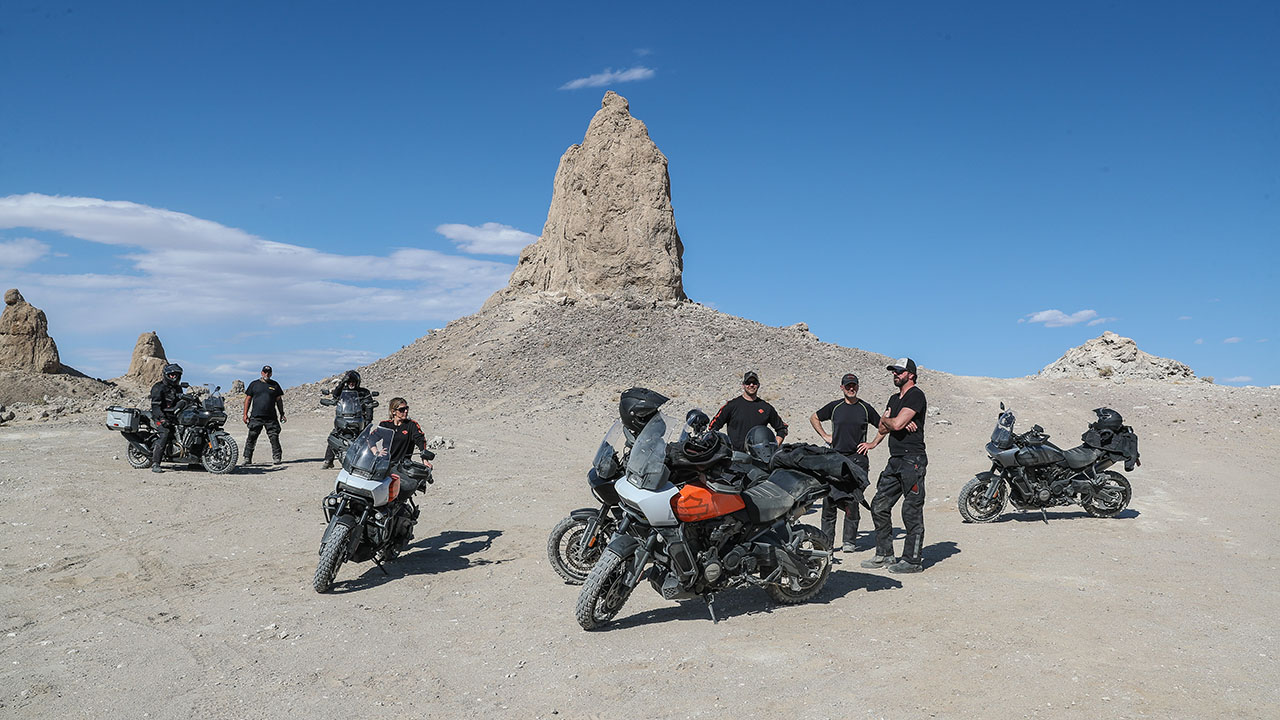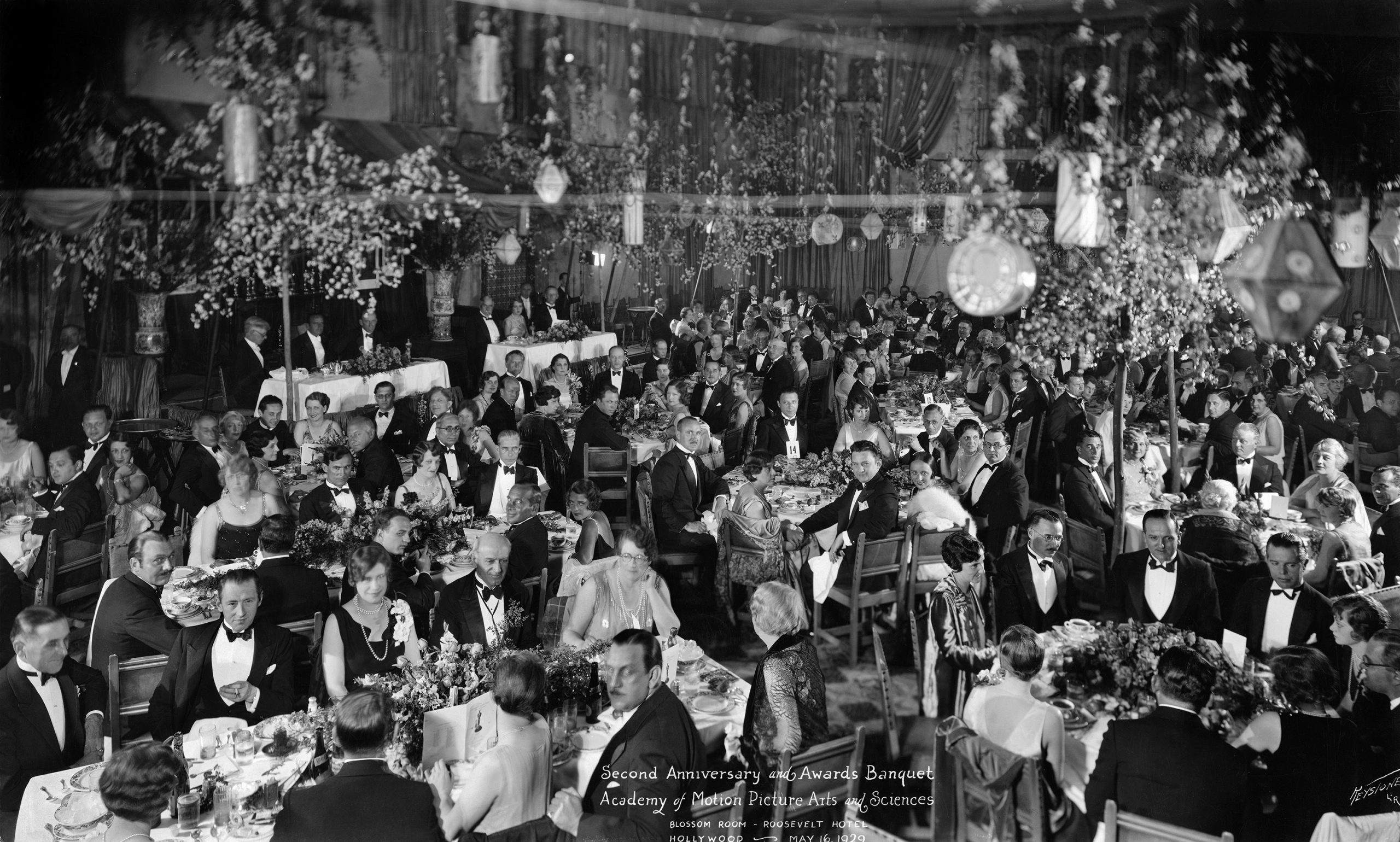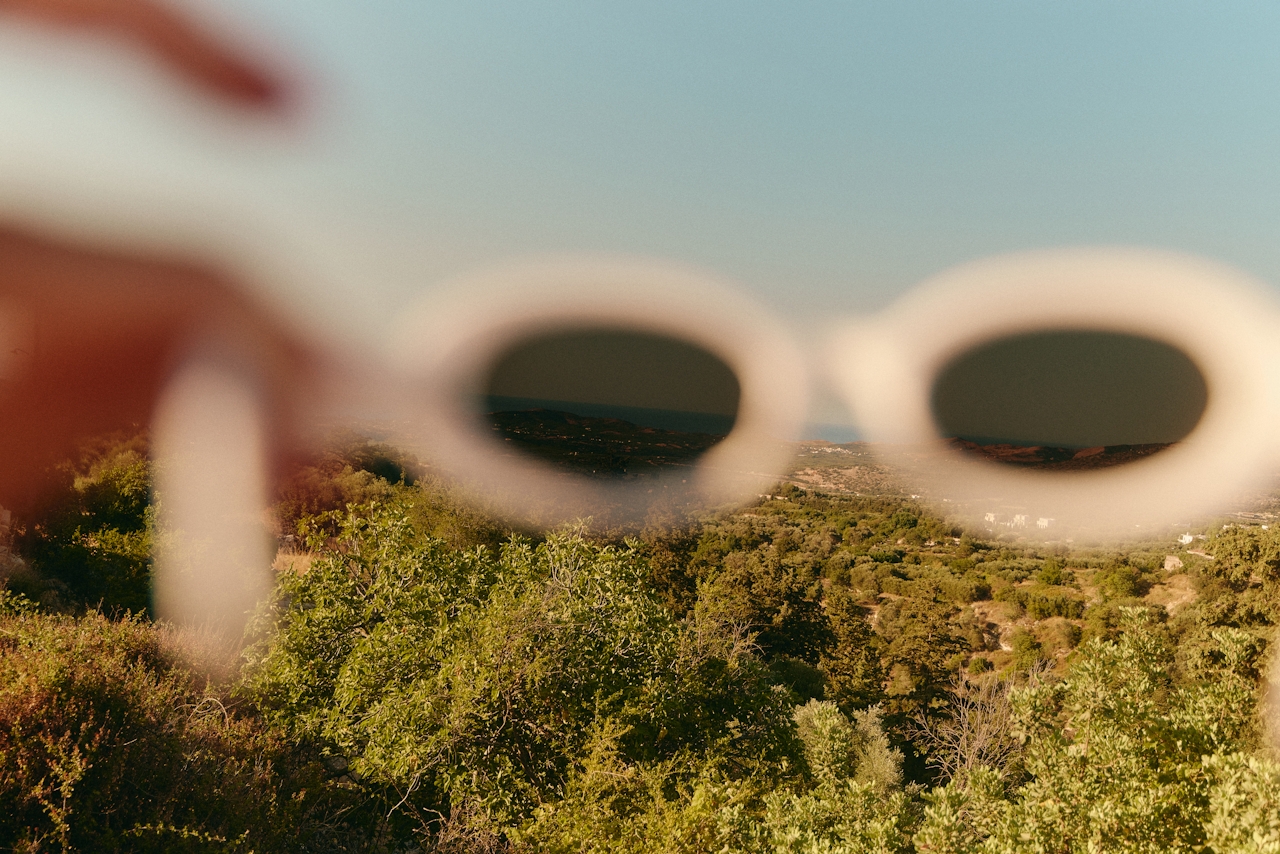Which would you rather have with your customers: transactions, or relationships?
Of course, the former is important. Increasing profit is one of the pillars of the WXO, and crucial for any successful business. But creating value isn’t just about turning a profit or improving retention rates: it’s about fostering meaningful relationships.
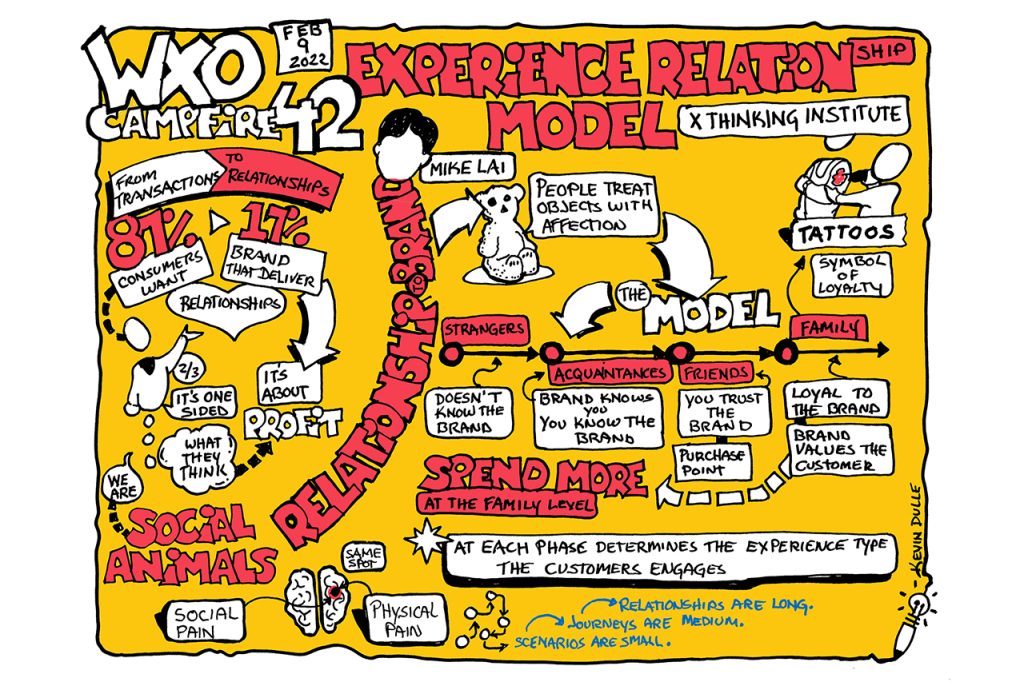
That’s why Dr Mike Lai from the X Thinking Institute, Shanghai, has formulated his Experience Thinking Relationship Model: a simple framework that shifts the conversation from transactions to relationships, and helps brands to select the best experience for each stage of the relationship they have with their customers.
Lai helps companies leverage experiences for their brands, figure out what their brand experience should be, and connect with their customers, using tools from user experience such as customer journey maps or experience models. This often involves breaking the experience down into different scenarios – for a hotel brand like IHG, for example, they not only look at the experience people have at the hotel, but the experiences of booking, research and inspiration.
However, having nailed how to help clients create extraordinary brand experiences, Lai began to wonder why he was doing so. Aside from increasing profit or user activation rates, or lowering customer acquisition costs, he felt that the key point had to be the creation of meaningful relationships.
The result was his book about the Experience Thinking Relationship Model, the first book about the Experience Economy written in Chinese. Having stayed up until 2.30am in Shanghai, Lai shared some insights about how any brand can apply his model. Here’s what we learned.
1. People Want Meaningful Relationships With Brands
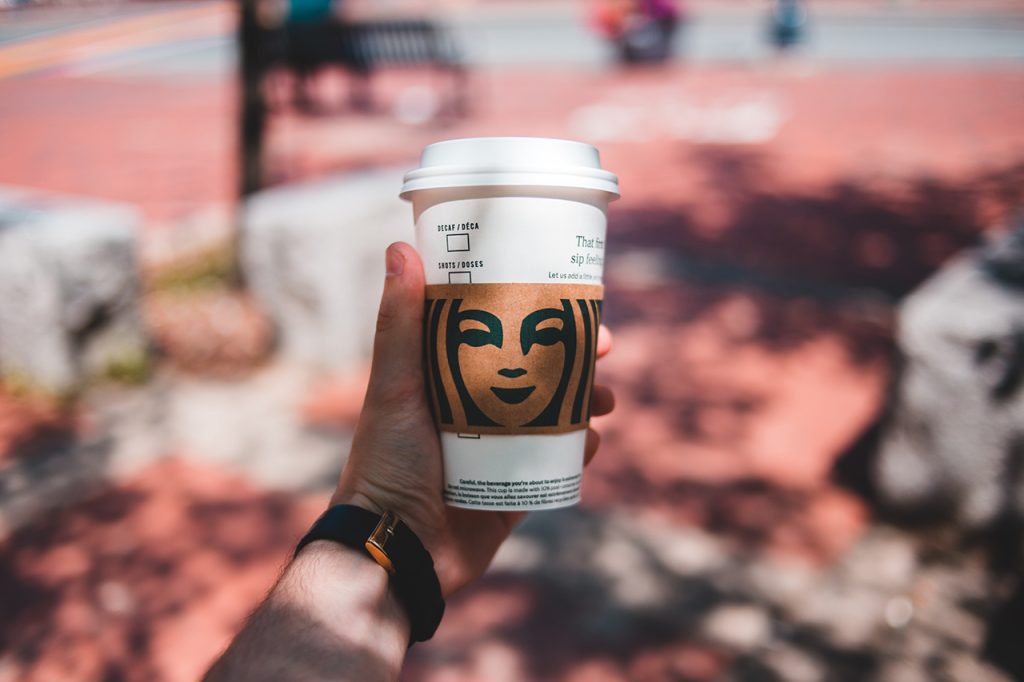
Many customer conversations are very transactional – getting them to buy more or enter into a contract for services. But studies show that 87% of consumers want a more meaningful relationship with brands – and that they feel only 7% of brands actually deliver this experience.
A huge 70% of consumers believe that the only reason brands share a relationship with them on social media is a self-centered desire to increase profits, and two-thirds say that they feel their relationships with brands are one-sided and limited in value.
Essentially, the balance in this relationship is way off where it should be. So how can we put relationships not only at the core of what we do as experience designers, but also at the core of what our clients do?
2. Man Is A Social Animal
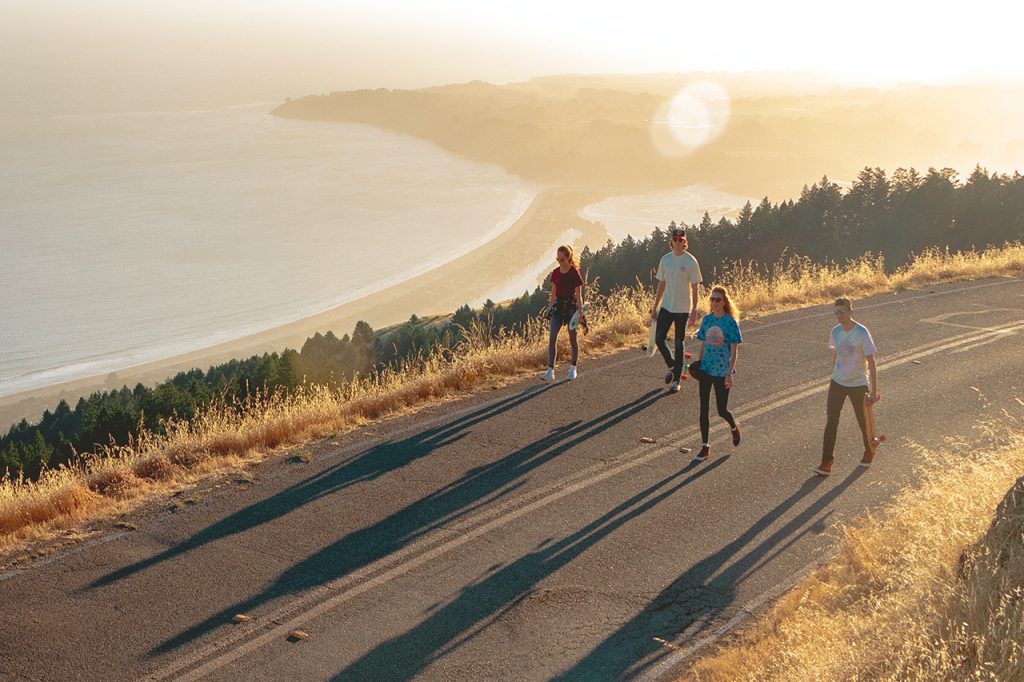
As well as consumer research, Lai draws inspiration from philosophy in thinking about the importance of relationships, looking to Aristotle.
“Man is by nature a social animal; an individual who is unsocial naturally and not accidentally is either beneath our notice or more than human.”
Aristotle
In other words, anyone who does not participate in society is either a beast or a god. Think of the reaction to various lockdowns during the pandemic: our nature is not to be isolated for long.
Matthew Lieberman, a professor and Social Cognitive Neuroscience Lab Director at UCLA, scanned brains using an MRI machine and discovered that the social pain felt when a loved one dies or you’re treated unfairly by a friend lights up the same parts of the brain as when you experience physical pain.
He also found that social pleasures, such as being treated well by others, light up the same parts of the brain as if you eat some delicious food, for example. His book Social shows that our brains are wired to connect with each other – we are social by nature.
And it’s not only other people that we enjoy having relationships with – we have relationships with inanimate objects too. Think of a child who wants to take their teddy to the doctor, or someone who yells at their car when it breaks down.
Just as people treat objects with affection (or anger!), they feel the same about brands – in China, logos and mascots are often based on animals, and with the advent of social media brands are able to respond to customers in a more instant and intimate way.
3. I Want To Marry My Motorcycle
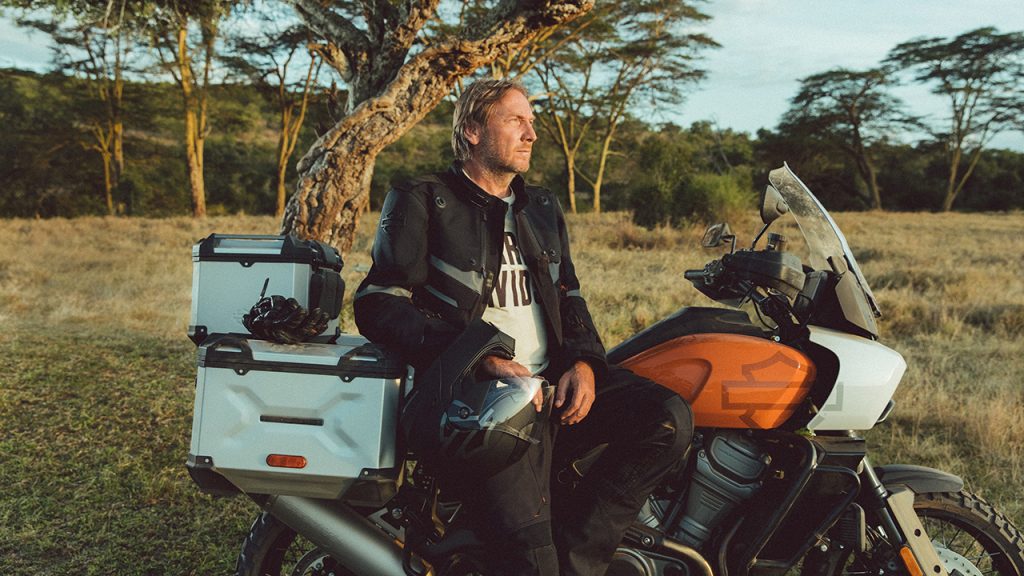
Based on these insights into human-to-human experiences, Lai developed the Experience Thinking Relationship Model. Just like you wouldn’t go up to a stranger and ask them to marry you, relationships with brands follow the same progressive model: from strangers to acquaintances to friends to family. Lai used the example of motorcycle brand Harley Davidson, whose brand followers are loyal to the point of tattooing its logo on their bodies, to show how this relationship might develop.
Strangers: the point in time where a person hasn’t heard of a brand, and the brand also doesn’t know them. A brand’s goal is to try to bring people in, create a really great first impression, and help them discover and connect with the brand.
Harley Davidson are already a recognised brand, but they still might not know all their potential customers: it’s a mutual (lack of) relationship. So to bring in the potentially “moto-curious”, who might think biking looks fun but scary, they have example models at fairs bolted to the ground so people can experience the power or riding, but not the danger. This is to help bring people in to make the brand feel more inviting for them to connect with them.
As experience designers, we might want to think about how we “warm people up” for an experience. Audette Sophia talked about how at her events, she helps people move from strangers to acquaintances by:
“…creating actual warm-ups that are designed for connection. Taking five or 10 minutes to purposefully get people feeling connected to each other. We put on a cocktail hour and hope that the booze and the casual mingling is going to make everyone feel connected, but introverts don’t necessarily feel that – so we have to design for it and actively facilitate it, which can be done through a game or it can be done through somebody leading it.”
Audette Sophia
Denise Cannon wondered if starting a relationship with a stranger depended on finding out your customers’ emotional needs.
“Stranger is more about first finding an awareness. But I think when you meet other strangers, in a way there’s a weeding-out process for both sides. There are certain things you will do with a stranger you probably won’t with a significant other and vice versa. So it’s truly understanding what mindset they are at that particular stage: what they’re willing to do and not willing to do, and what they’re willing to commit to and not willing to commit to.”
Dr Mike Lai
(Side note: this “weeding out” is what we do in our WXO application form, to check that the relationship is/will be aligned.)
Acquaintances: when a person and the brand know each other, but aren’t necessarily close. Before you’re willing to get closer and purchase anything, you need to build familiarity, understanding and trust.
Harley Davidson has weekly classes available to anyone who’s interested in getting their motorcycle license, regardless of whether they’re a customer or not, and even sponsor the state classes in Ohio. This lowers the barrier into potentially buying a motorcycle and creates trust.
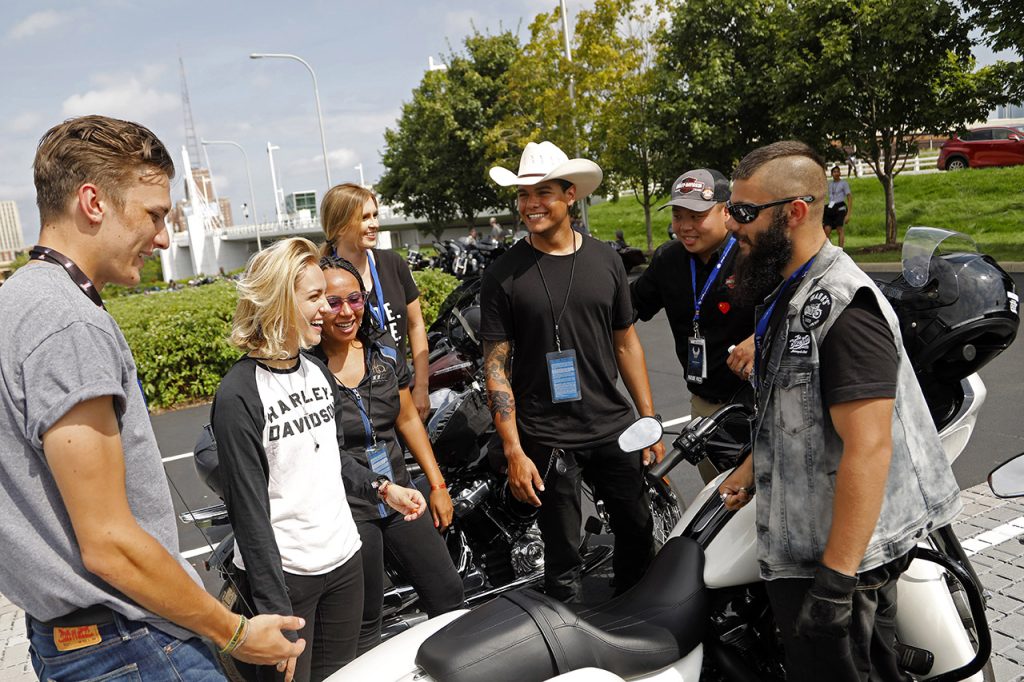
Friends: when you feel comfortable together and trust each other, choose to spend more time with that brand than you would with other brands, and the purchase action begins as the brand helps people accomplish their goals through their products and/or services.
Harley Davison created the Harley Owners Group. It normally requires a $45 per year membership fee, but they provide the first year free and plan and sponsor over 80,000 events per year. They have over 1,400 chapters all over the world. And they plan weekly rides that any motorcycle owner can join, not just those who ride Harleys. This keeps a connection between the people that own and continuously use the bike and helps them stay connected with that community.

Family: when you are really committed. If the brand was a person, you might marry it – or at least become loyal to and advocate for it above all other brands. The brand also values the customer’s interactions and opinions, and aims to grow together with them.
Harley Davidson does this by having major events, such as their 110th anniversary in 2013 when they organised concerts, hosted factory tours and threw parades through downtown Milwaukee. There were over 130,000 hotel reservations in the area during the celebrations.
And as of 2016, Harley had over a million members worldwide. People who were part of the HOG group rode their bikes 27% more than non-members, and also spent 170% more on accessories and 57% more on merchandise.
4. Combining Models For Better Brand Experiences

The Experience Thinking Relationship Model can be used with other models to deliver what clients need. Lai talked about one of his projects launching a car brand in China by helping them to understand the importance of the relationship they build with their customers beyond the sales funnel.
Lai mapped out all the relationships against scenarios – for example, how a stranger researching different car brands might connect with the brand, or how you might show a “family” member an exceptional level of loyalty. This is because while there are multiple customer journeys, at different stages in your relationship with a brand you also want different experiences. The relationship is defined by how close you are to the brand, not just where you are in the sales funnel or customer journey.
You can also map out the relationship model against the different types of experiences: offerings (products and services), communications, behaviours (employee or AI), environments (online/offline). This forms a master plan for a company trying to deliver an experience to a customer, as it defines all the scenarios and the touchpoints needed to deliver them. In order to create a holistic experience you also need all departments to collaborate, so the master plan defines everything the customer and/or client must do to achieve this.
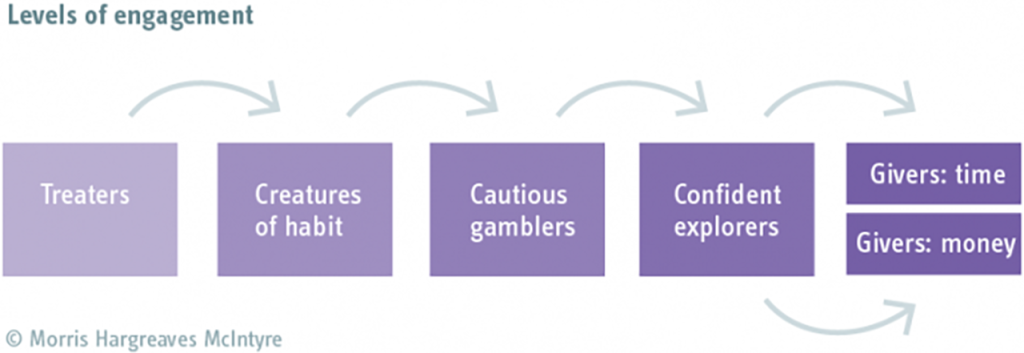
Experience designer Pigalle Tavakkoli had a great example of a storytelling campaign she had designed for a retailer that used the Morris Hargreaves McIntyre model for levels of engagement, developed for cultural organisations to move the audience involvement with them through different levels, but which could also map against the Experience Thinking Relationship Model.

“We did a storytelling campaign based on unlocking the secrets of fashion. To attract the attention of strangers, we put up hundreds of beautiful white birdcages in the middle of the night, and hung them quite low because we wanted people to steal them. And then we counted over the days how many got stolen, just to rate the success of it. And quite a lot did.
The second stage of acquaintance was that we made these beautiful gold keys with gift tags, formed partnerships with local businesses, and then people would find these keys in a treasure box. The gift tag was a discount that gave the date and the location of the launch.
On the day of the launch, to become friends, we installed a life-size birdcage with models performing as birds and a giant nest giving more keys. It caused a big fuss so people went into the store and became friends.
For two weeks afterwards, people were still bringing the keys back to the store or those that hadn’t redeemed it on the day but were really interested kept coming back. Hopefully they had started to become family.”
Pigalle Tavakkoli
5. Scenarios Are Small, Journeys Are Medium, Relationships Are Long

Just as the model progresses from stranger to family, relationships are also made up of multiple components that get bigger as they progress.
Scenarios are small. Multiple scenarios add up to become journeys.
Journeys are medium. When a customer purchases something, they are going through a customer journey – but they normally purchase the thing more than once, and the experience the first time will be different to the fifth time. Multiple journeys add up to become relationships.
Relationships are long. They are a process – you don’t go from meeting someone on the street to marrying them overnight. They are dynamic – people are constantly changing to have new goals and embrace new selves. And they need nurturing – both parties need to invest time, energy and money into them, but are rewarded with trust, loyalty and advocacy.
6. Relationships Are Built On Experiences

Philopopher John Dewey talks about how culture is built on shared experiences. Think about how you and the people close to you have joint experiences where you go through a struggle together – you can have a holiday that is less than spectacular and where things just go wrong, but because you had it with that person you have stories about it and it brings you closer together. These are experiences that help create this bond or tear you apart, and can be truly transformational.
Lori Buscaglia talked about creating these shared experiences in a public health facility she is designing, which has various experiential areas.
“The goal was to support, elevate and tease out the creativity of scientists. You’ve got visitors, so students or other people that maybe have never visited the building before, where things like the colorful spine will appeal and create curiosity. But as you have a deeper relationship in the building and with the other scientists, then maybe you’re more collaborative and solving the question of the day.
How do you take the super fandom you see in sports, that really intense engagement, and help customers to point it towards their life, so you’re creating more of a transformational experience that isn’t just focused with that brand or with that team or with that work?”
Lori Buscaglia
The WXO Take-Out
- Creating value isn’t just about creating profit: it’s about sparking meaningful relationships between people and brands.
- People are wired to connect and be social, and also to crave these positive relationships with brands.
- By understanding the type of relationship a person is currently having with a brand – and how it might evolve – we can deepen our understanding of what they’re willing to commit, and map it against their place on the customer journey.
- Experience designers might therefore want to ask themselves…
- How do you design an experience with friends differently to time spent with family?
- What brands do you have a relationship with that you might call ‘best friend’, ‘partner’, ‘family’ or ‘lover’?
- Do you already design different experiences for people at different stages / in different types of relationship with your brand? How?
Want to be part of the most inspiring experience conversations in the world? Apply to become a member of the World Experience Organization here – to come to Campfires, become a better experience designer, and be listed in the WXO Black Book.

